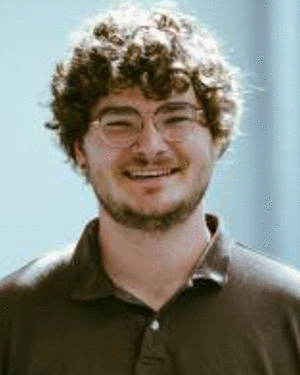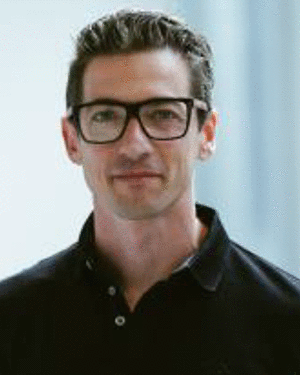Abstract:
Wearable robots and powered exoskeletons may improve ambulation for millions of individuals with poor mobility. Powered exoskeletons primarily assist in the sagittal plan...Show MoreMetadata
Abstract:
Wearable robots and powered exoskeletons may improve ambulation for millions of individuals with poor mobility. Powered exoskeletons primarily assist in the sagittal plane to improve walking efficiency and speed. However, individuals with poor mobility often have limited mediolateral balance, which requires torque generation in the frontal plane. Existing hip exoskeletons that assist in both the sagittal and frontal planes are too heavy and bulky for use in the real world. Here we present the kinematic model, mechatronic design, and benchtop and human testing of a powered hip exoskeleton with a unique parallel kinematic actuator. The exoskeleton is lightweight (5.3 kg), has a slim profile, and can generate 30 N·m and 20 N·m of torque during gait in the sagittal and frontal planes. The exoskeleton torque density is 5.7 N·m/kg—53% higher than previously possible with series kinematic design. Testing with five healthy subjects indicate that frontal plane torques applied during stance or swing can alter step width, while sagittal plane torque can assist with hip flexion and extension. A device with these characteristics may improve both gait economy and balance in the real world.
Published in: IEEE Transactions on Robotics ( Volume: 41)
Funding Agency:

Department of Mechanical Engineering and the Robotics Center, University of Utah, Salt Lake City, UT, USA
Dante Archangeli received the B.S. degree in mechanical engineering from Yale University, New Haven, CT, USA, in 2017, and the M.S. degree in mechanical engineering from the University of Utah, Salt Lake City, UT, USA, in 2022. He is currently working toward the Ph.D. degree in mechanical engineering in the University of Utah.
He is currently a Graduate Research Assistant with the HGN Lab for Bionic Engineering, University...Show More
Dante Archangeli received the B.S. degree in mechanical engineering from Yale University, New Haven, CT, USA, in 2017, and the M.S. degree in mechanical engineering from the University of Utah, Salt Lake City, UT, USA, in 2022. He is currently working toward the Ph.D. degree in mechanical engineering in the University of Utah.
He is currently a Graduate Research Assistant with the HGN Lab for Bionic Engineering, University...View more

Department of Mechanical Engineering and the Robotics Center, University of Utah, Salt Lake City, UT, USA
Brendon Ortolano received the B.S. degree in mechanical engineering from the University of West Florida, Pensacola, FL, USA, in 2021, and the M.S. degree in mechanical engineering from the University of Utah, Salt Lake City, UT, USA, in 2024. He is currently working toward the Ph.D. degree in robotics in the University of Utah.
He is currently a Graduate Research Assistant with the HGN Lab for Bionic Engineering, Universit...Show More
Brendon Ortolano received the B.S. degree in mechanical engineering from the University of West Florida, Pensacola, FL, USA, in 2021, and the M.S. degree in mechanical engineering from the University of Utah, Salt Lake City, UT, USA, in 2024. He is currently working toward the Ph.D. degree in robotics in the University of Utah.
He is currently a Graduate Research Assistant with the HGN Lab for Bionic Engineering, Universit...View more

Department of Mechanical Engineering and the Robotics Center, University of Utah, Salt Lake City, UT, USA
Rosemarie Murray received the B.Sc. and Ph.D. degrees in mechanical engineering from Columbia University, New York, NY USA, in 2016 and 2022, respectively.
She is currently a Postdoctoral Scholar with the HGN Lab for Bionic Engineering, University of Utah, Salt Lake City, UT, USA. Her research interests include the interplay between robotic control, biomechanics, and human motor adaptation in assistive robotics.
Rosemarie Murray received the B.Sc. and Ph.D. degrees in mechanical engineering from Columbia University, New York, NY USA, in 2016 and 2022, respectively.
She is currently a Postdoctoral Scholar with the HGN Lab for Bionic Engineering, University of Utah, Salt Lake City, UT, USA. Her research interests include the interplay between robotic control, biomechanics, and human motor adaptation in assistive robotics.View more

Department of Mechanical Engineering and the Robotics Center, University of Utah, Salt Lake City, UT, USA
Rocky Mountain Center for Occupational and Environmental Health, Salt Lake City, UT, USA
Lukas Gabert received the B.Sc. degree from the New Mexico Institute of Mining and Technology, Socorro, NM, USA, in 2016, and the M.Sc. and Ph.D. degrees from the University of Utah, Salt Lake City, UT, USA, in 2019 and 2022, respectively, all in mechanical engineering.
He is currently a Research Scientist at the HGN Lab for Bionic Engineering at the University of Utah. He has extensive experience in the design, developmen...Show More
Lukas Gabert received the B.Sc. degree from the New Mexico Institute of Mining and Technology, Socorro, NM, USA, in 2016, and the M.Sc. and Ph.D. degrees from the University of Utah, Salt Lake City, UT, USA, in 2019 and 2022, respectively, all in mechanical engineering.
He is currently a Research Scientist at the HGN Lab for Bionic Engineering at the University of Utah. He has extensive experience in the design, developmen...View more

Department of Mechanical Engineering and the Robotics Center, University of Utah, Salt Lake City, UT, USA
Rocky Mountain Center for Occupational and Environmental Health, Salt Lake City, UT, USA
Department of Biomedical Engineering, University of Utah, Salt Lake City, UT, USA
Tommaso Lenzi (Member, IEEE) received the Ph.D. degree in biorobotics from Scuola Superiore Sant'Anna, Pisa, Italy, in 2012.
He is currently an Associate Professor with the Department of Mechanical Engineering, University of Utah, Salt Lake City, UT, USA, where he directs the HGN Lab for Bionic Engineering. He is also a Core Faculty with the Utah Robotics Center, Salt Lake City, and the Director of the Ergonomics and Safet...Show More
Tommaso Lenzi (Member, IEEE) received the Ph.D. degree in biorobotics from Scuola Superiore Sant'Anna, Pisa, Italy, in 2012.
He is currently an Associate Professor with the Department of Mechanical Engineering, University of Utah, Salt Lake City, UT, USA, where he directs the HGN Lab for Bionic Engineering. He is also a Core Faculty with the Utah Robotics Center, Salt Lake City, and the Director of the Ergonomics and Safet...View more

Department of Mechanical Engineering and the Robotics Center, University of Utah, Salt Lake City, UT, USA
Dante Archangeli received the B.S. degree in mechanical engineering from Yale University, New Haven, CT, USA, in 2017, and the M.S. degree in mechanical engineering from the University of Utah, Salt Lake City, UT, USA, in 2022. He is currently working toward the Ph.D. degree in mechanical engineering in the University of Utah.
He is currently a Graduate Research Assistant with the HGN Lab for Bionic Engineering, University of Utah. His research interests include exoskeletons and rehabilitation robotics.
Dante Archangeli received the B.S. degree in mechanical engineering from Yale University, New Haven, CT, USA, in 2017, and the M.S. degree in mechanical engineering from the University of Utah, Salt Lake City, UT, USA, in 2022. He is currently working toward the Ph.D. degree in mechanical engineering in the University of Utah.
He is currently a Graduate Research Assistant with the HGN Lab for Bionic Engineering, University of Utah. His research interests include exoskeletons and rehabilitation robotics.View more

Department of Mechanical Engineering and the Robotics Center, University of Utah, Salt Lake City, UT, USA
Brendon Ortolano received the B.S. degree in mechanical engineering from the University of West Florida, Pensacola, FL, USA, in 2021, and the M.S. degree in mechanical engineering from the University of Utah, Salt Lake City, UT, USA, in 2024. He is currently working toward the Ph.D. degree in robotics in the University of Utah.
He is currently a Graduate Research Assistant with the HGN Lab for Bionic Engineering, University of Utah. His research interests include the design and control of assistive and rehabilitative wearable robots.
Brendon Ortolano received the B.S. degree in mechanical engineering from the University of West Florida, Pensacola, FL, USA, in 2021, and the M.S. degree in mechanical engineering from the University of Utah, Salt Lake City, UT, USA, in 2024. He is currently working toward the Ph.D. degree in robotics in the University of Utah.
He is currently a Graduate Research Assistant with the HGN Lab for Bionic Engineering, University of Utah. His research interests include the design and control of assistive and rehabilitative wearable robots.View more

Department of Mechanical Engineering and the Robotics Center, University of Utah, Salt Lake City, UT, USA
Rosemarie Murray received the B.Sc. and Ph.D. degrees in mechanical engineering from Columbia University, New York, NY USA, in 2016 and 2022, respectively.
She is currently a Postdoctoral Scholar with the HGN Lab for Bionic Engineering, University of Utah, Salt Lake City, UT, USA. Her research interests include the interplay between robotic control, biomechanics, and human motor adaptation in assistive robotics.
Rosemarie Murray received the B.Sc. and Ph.D. degrees in mechanical engineering from Columbia University, New York, NY USA, in 2016 and 2022, respectively.
She is currently a Postdoctoral Scholar with the HGN Lab for Bionic Engineering, University of Utah, Salt Lake City, UT, USA. Her research interests include the interplay between robotic control, biomechanics, and human motor adaptation in assistive robotics.View more

Department of Mechanical Engineering and the Robotics Center, University of Utah, Salt Lake City, UT, USA
Rocky Mountain Center for Occupational and Environmental Health, Salt Lake City, UT, USA
Lukas Gabert received the B.Sc. degree from the New Mexico Institute of Mining and Technology, Socorro, NM, USA, in 2016, and the M.Sc. and Ph.D. degrees from the University of Utah, Salt Lake City, UT, USA, in 2019 and 2022, respectively, all in mechanical engineering.
He is currently a Research Scientist at the HGN Lab for Bionic Engineering at the University of Utah. He has extensive experience in the design, development, and testing of wearable robots. His research interest includes the intersection of mechanical design,
embedded systems, and controls.
Lukas Gabert received the B.Sc. degree from the New Mexico Institute of Mining and Technology, Socorro, NM, USA, in 2016, and the M.Sc. and Ph.D. degrees from the University of Utah, Salt Lake City, UT, USA, in 2019 and 2022, respectively, all in mechanical engineering.
He is currently a Research Scientist at the HGN Lab for Bionic Engineering at the University of Utah. He has extensive experience in the design, development, and testing of wearable robots. His research interest includes the intersection of mechanical design,
embedded systems, and controls.View more

Department of Mechanical Engineering and the Robotics Center, University of Utah, Salt Lake City, UT, USA
Rocky Mountain Center for Occupational and Environmental Health, Salt Lake City, UT, USA
Department of Biomedical Engineering, University of Utah, Salt Lake City, UT, USA
Tommaso Lenzi (Member, IEEE) received the Ph.D. degree in biorobotics from Scuola Superiore Sant'Anna, Pisa, Italy, in 2012.
He is currently an Associate Professor with the Department of Mechanical Engineering, University of Utah, Salt Lake City, UT, USA, where he directs the HGN Lab for Bionic Engineering. He is also a Core Faculty with the Utah Robotics Center, Salt Lake City, and the Director of the Ergonomics and Safety Program with the Rocky Mountain Center for Occupational and Environmental Health, Salt Lake
City.
Tommaso Lenzi (Member, IEEE) received the Ph.D. degree in biorobotics from Scuola Superiore Sant'Anna, Pisa, Italy, in 2012.
He is currently an Associate Professor with the Department of Mechanical Engineering, University of Utah, Salt Lake City, UT, USA, where he directs the HGN Lab for Bionic Engineering. He is also a Core Faculty with the Utah Robotics Center, Salt Lake City, and the Director of the Ergonomics and Safety Program with the Rocky Mountain Center for Occupational and Environmental Health, Salt Lake
City.View more

